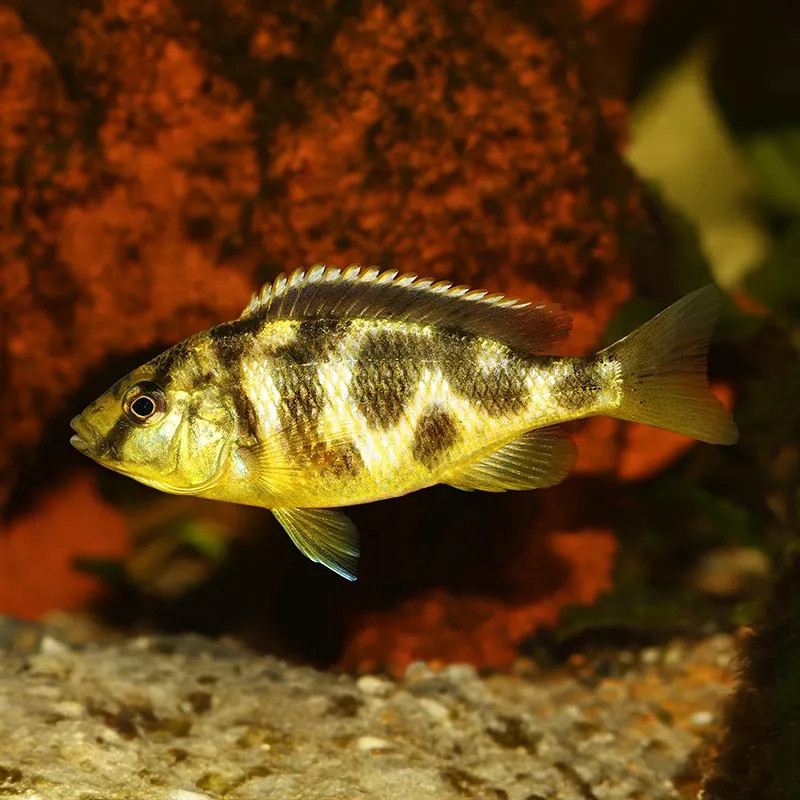Stocks Available
Angel Ram
SKU:118889
MIKROGEOPHAGUS RAMIREZI
1 INCH

Stock Available
Introduction:
Common Names: Venustus Cichlid, Giraffe Hap, Giraffe Cichlid.
Natural Habitat: Native to Lake Malawi in East Africa, primarily found in sandy and rocky regions. Known for their ambush hunting behavior, where they mimic the appearance of the lakebed to surprise prey.
Physical Characteristics:
Appearance: Named for its giraffe-like pattern, this cichlid displays a tan body with irregular dark brown blotches. Males develop a vibrant blue head and yellow coloration on their fins and body as they mature. Females retain the giraffe-like pattern with less vibrant coloration.
Size: Grows to about 10-12 inches (25-30 cm) in captivity.
Lifespan: 7-10 years with proper care.
Habitat Requirements:
Tank Size: Minimum of 125 gallons for adults due to their large size and active swimming behavior.
Water Conditions:
Temperature: 76-82°F (24-28°C).
pH: 7.8-8.6 (alkaline).
Hardness: 10-20 dGH.
Aquascaping: Provide a mix of open swimming areas and rocky hiding spots. A sandy substrate is ideal to mimic their natural habitat and support their hunting behavior.
Diet:
Primary Diet: Carnivorous; feeds on smaller fish, invertebrates, and crustaceans in the wild.
Supplemental Feeding: Offer high-quality cichlid pellets or sticks, along with frozen or live foods like shrimp, krill, and small fish. Avoid overfeeding to prevent obesity and health issues.
Feeding Frequency: Feed once or twice daily in moderate amounts.
Compatibility:
Temperament: Semi-aggressive and territorial, especially as they mature. Dominant males can become particularly assertive.
Suitable Tank Mates: Best kept with other large, robust African cichlids such as Frontosas (Cyphotilapia frontosa), other Haps, or Mbuna species.
Incompatibilities: Avoid small, peaceful fish or slow-moving species, as they may be seen as prey.
Care Level:
Difficulty: Moderate; requires a large tank, stable water conditions, and careful management of tank dynamics to prevent aggression.
Health Monitoring: Keep an eye out for Malawi bloat, ich, and other common cichlid ailments. Regular water changes and a proper diet are essential for their health.
Breeding:
Breeding in Captivity: Achievable for experienced aquarists. Venustus Cichlids are maternal mouthbrooders.
Spawning: Males establish territories and display vibrant colors to attract females. Females lay eggs, which they collect in their mouths for incubation (about 21-28 days).
Tips: Provide multiple females per male to reduce aggression and increase breeding success. Fry can be fed finely crushed flakes or specialized fry food.
Economic Considerations:
Market Demand: Popular for their unique pattern and large size, making them a centerpiece species in African cichlid setups.
Pricing: Moderate; prices may vary based on size, age, and sex (mature males are often priced higher due to their vibrant coloration).
Conclusion:
The Venustus Cichlid is a stunning and intriguing species, ideal for aquarists who can provide a spacious tank and maintain a suitable environment. Their giraffe-like pattern and vibrant adult coloration make them a striking addition to African cichlid aquariums. With proper care and attention to their territorial nature, they can thrive and display their natural behaviors.
Data sheet
16 other products in the same category: